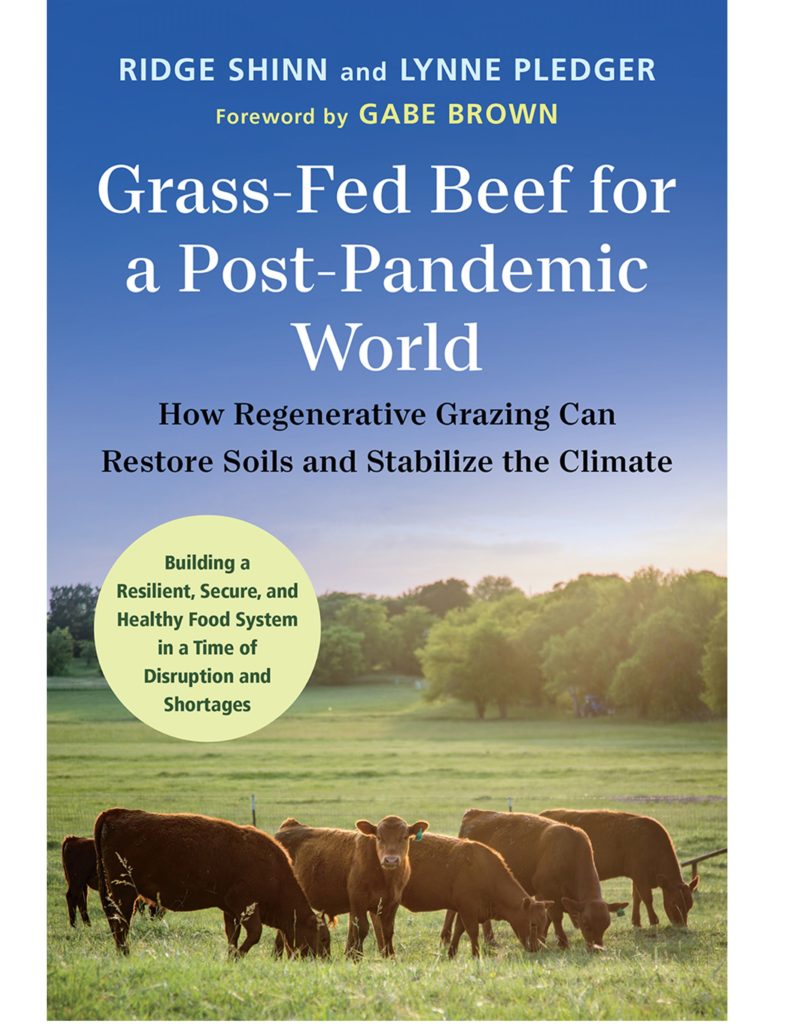Long-time holistic grazier Ridge Shinn and writer and environmentalist Lynne Pledger have recently added their book to the list of books explaining how grassfed protein can be good for human, animal, and planetary health. Their book is particularly timely given its post-pandemic publication and title: Grass-Fed Beef for a Post-Pandemic World: How Regenerative Grazing Can Restore Soils and Stabilize the Climate. It has an additional subtitle: “Building a Resilient, Secure, and Healthy Food System in a Time of Disruption and Shortages.”
Ridge was the founding CEO of Big Picture Beef, a 100% grass-fed beef company, partnering with farmers throughout the Northeast United States. He was also the founding director of the New England Livestock Alliance, which helped farmers find markets for their meat. Ridge has consulted all over North America, in New Zealand, England, Uruguay, and Argentina, and for the Lakota of the Cheyenne River Reservation. His work has been reported on in Smithsonian, the Atlantic, the New York Times, and TIME magazine.
While Grass-Fed Beef for a Post-Pandemic World follows in the footsteps of books likeDefending Beef, I think this book speaks most directly to the conventional producer considering transitioning to grassfed beef production or could be used by a grassfed producer to help transition their more mainstream neighbors.
However, the first section of the book titled, “Impacts of Regenerative Grazing,” nicely spells out the potential for improving land health, sequestering carbon, stabilizing the climate, providing nutrient dense food, and improving animal welfare. Any conscious consumer who would like to educate other compassionate carnivores will find lots of good information to share in this section.
Likewise, those interested in policies and how to get more regenerative grazing in the U.S. will find numerous examples of the kinds of policy change necessary to level the playing field and get us on the right agricultural track.
But the middle section of the book titled, “Keys to Success with Grass-Fed Beef,” is where I think this book really adds some critical new information. Here Ridge shares all his experience from consulting around the world and telling stories of the work he did with different clients to help them make that transition from conventional cattle farming to regenerative grazing for profitable grassfed beef production. He covers everything from how to reduce inputs to breeding with hybrid vigor to choosing moderately framed animals to help producers see how they could turn a profit in a low-margin business.
Some numbers that stand out to make any producer want to get into the grassfed business is that store sales increased by 30% from 2019-2022. Likewise, sales increased from $17 million to $480 million in the years from 2012-2019. While these market demands are very tempting, the reality is that 97% of cattle in the U.S. is still cornfed. Likewise, the challenges of scaling this type of production are daunting due to:
Lack of capital
Shortage of regenerative graziers
Getting sufficient good practices in place for creating a large supply of consistently high quality 100% grassfed cattle
The need for aggregation of herds to reach economies of scale
The need for transparency and traceability for grassfed cattle
The need for high quality, affordable processing facilities to get these animals to market.
Throughout all this data, Lynne weaves case studies of regenerative graziers and the results they’ve achieved including Holistic Management practitioners like the Wobesers in Canada, Alejandro Carrillo in Chihuahua Mexico, and Gabe Brown from North Dakota.
Ridge and Lynne end their book focused on how we must address the remaining challenges of scaling grassfed beef caused by the inequity inherent with the monopoly of the large meat packers as well as the issues caused by the loss of a skilled labor pool both for processing and grazing. However, the shakeup that happened during COVID has shown the vulnerabilities of the larger food system, encouraging change. The authors note that now is the time to shorten the supply chain to shock proof the food system.
They also call for ending the subsidies of corn and restoring the Country of Origin labeling as ways to shift those dynamics. They acknowledge that there are many misguided policies or consumer-driven focuses like lab/fake/cellular meat that are a result of people’s misunderstanding of livestock’s potential to improve human and climate health. For example, they say there are some policies currently being explored and even funded that are more technologically risky and costly than investing in regenerative grazing: like refreezing the North and South Poles by spraying salt into the clouds above those regions for greater reflectivity; or fertilizing the oceans to encourage the growth of plant matter to absorb CO2 or injecting captured CO2 into deeper parts of the ocean.
The bottom line is we need to educate more producers, consumers, and policy makers to see the potential of solving multiple problems with regenerative grazing. Grass-Fed Beef for a Post-Pandemic World demonstrates how grassfed beef could be the common ground amidst the partisan divide around climate change, to help us restore our soils and build a resilient food system in challenging times.
To purchase this book, go to: https://www.chelseagreen.com/product/grass-fed-beef-for-a-post-pandemic-world/

